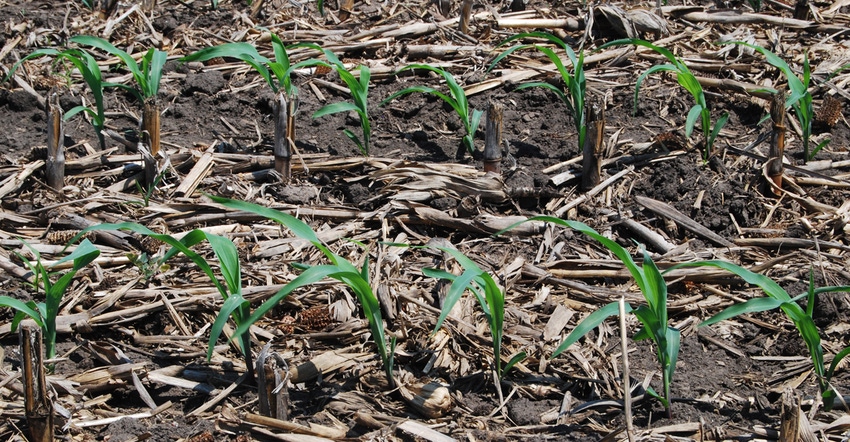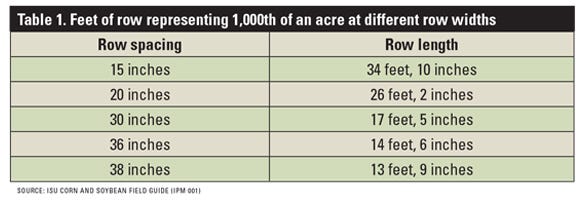April 25, 2019

Invariably, each spring throughout Iowa, we have fields or areas within fields where we question our corn stands and try to determine if the stand is good enough to attain the highest potential yield, or be replanted.
Mother Nature, soil conditions at planting, our own management decisions and particular pests (sometimes a combination) are often the cause of needing to evaluate whether or not to replant.
The first step in this evaluation is to estimate the corn population in the field. This can be done by referring to Table 1, which tells you the number of feet to measure per row that is equal to a 1,000th of an acre for various row widths.

Simply count the plants in the row and multiply by 1,000 to obtain the final plant population per acre. Make sure to conduct this procedure in at least six representative areas across the field. Try to make a zig-zag pattern across the field to best represent its overall condition. Do not intentionally avoid areas in rows with gaps; include these in areas assessed.
2 factors in replanting decisions
Often two main situations cause producers to consider replanting. The first is when corn is emerging non-uniformly, resulting in different plant developmental stages within a row. Replanting a field like this will not be a benefit, if plant populations are reasonable. Although the smaller plants compete with their larger neighbors for resources, only extreme conditions warrant replanting.
If the delay in emergence is less than two weeks between the early- and late-emerging plants, replanting may increase yields, but by only 5% or less. Replanting would likely not be economical. If half the plants are two leaves behind the growth stage of the rest of the plants within a row, yields can be reduced by 5% to10%.
To estimate yield loss in fields exhibiting non-uniform development, refer to “Tools to calculate yield loss from uneven heights” from ISU Extension’s Integrated Crop Management.
If several 4- to 6-foot gaps occur within the row, yields will be reduced an additional 5% relative to a uniform stand. Stand gaps of 16 to 33 inches will only reduce yield by 2%.
The second situation that may cause a farmer to consider replanting is when corn populations are significantly lower than desired. Replanting may benefit the producer in this case.
Above- and belowground factors
As the field or area is being assessed for population, this is also a chance to determine what caused the stand loss. Many times, you can’t pinpoint the problem by looking at only aboveground symptoms of the plant. You will also need to dig the entire seedling out of the ground and inspect the seed and roots. Here are some considerations:
Seed quality, viability. The seed lot may have had poor germination ratings from the start. Check the seed tag or run your own germination test.
Insects. The most common insects that can affect seedlings and reduce stands are cutworms, armyworms, white grubs and wireworms. Currently, the only insect that has a labeled rescue treatment is cutworms. Be sure to follow label guidelines.
Seedling diseases. Seedling diseases of corn (seed rots, seedling blights and/or root rots) are caused by numerous fungi including pythium, fusarium, rhizoctonia, aspergillus, penicillium and trichoderma, all of which are common inhabitants of soils. In addition, these fungi also can be seedborne in corn, except pythium.
Seedling susceptibility to infection increases the longer the seed sits in the ground, and the more stress germinating corn undergoes. Corn germinates well at soil temperatures above 68 degrees F. When soil temperatures are below 55 degrees, germination is greatly retarded. Thus, seedling disease often is more severe in early planted, or no-till or reduced tillage fields because of cool soil temperatures.
Typical belowground symptoms associated with seedling disease include rotting seed and brown discoloration (rotting) of the mesocotyl and seminal roots. It is sometimes possible to determine in the lab which fungus is the culprit. However, this information isn’t crucial since management options are the same for all seedling diseases: plant high-quality fungicide-treated seed, plant when soil temperatures are above 50 degrees, and ensure planting depth isn’t too deep.
Soil compaction, crusting. Seedling emergence can be severely reduced due to sidewall compaction and surface crusting. Check planter settings for each field and as conditions change through the day. Also, assess soil moisture conditions, particularly poorly drained areas.
Soil temperatures. We’ve seen in some years (2012 and 2017) where early-planted corn had been subjected to imbibitional chilling (seedling absorbs water from cold soils within 48 hours of planting), which may cause reduction in corn stands. Also, no-till fields in a continuous corn rotation will exhibit delayed emergence due to the heavy corn residue. This surface residue delays the rise in soil temperature compared to disked, strip till or ridge till fields, and fields that were planted with soybeans the previous year.
Calculate expected yield
Once the plant stand is determined, the next step is to calculate the expected yield from the existing stand. The potential yield associated with the original planting date with the actual population will give a fair estimate of the actual yield of the problematic field.
Table 2 summarizes planting date and plant population (final stand) relationships. For example, if the original planting date was April 30, a population of 35,000 plants per acre is expected to provide maximum yield, based on Table 2. If the population is only 20,000 plants acre, yield potential is still 89% of maximum.

Now, estimation of replant yield needs to be calculated. Planting date and target plant population are used to estimate the yield potential of the replanted field. Use Table 2 for this, too. Replanting on May 20 at 35,000 plants per acre will result in approximately 87% of maximum yield.
Compare the replanted crop to the original crop that was planted on April 30, which has an existing population of 20,000 plants per acre, and then consider the costs of replanting. Expected yields are 89% for retaining the old stand vs. 87% for a replant. Remember, there is no guarantee of getting a good stand with replanting. Insect and disease pressure may also be greater in replanted fields.
Don’t forget to estimate replanting costs. The cost of replanting a field is often the deciding factor. Costs include tillage, seed, fuel (for tillage and planting), additional pesticides, labor, etc. Moreover, the chance of a fall frost causing problems is higher for late-planted corn coupled with higher grain moisture at harvest. Check with your seed dealer to see what hybrid seed (shorter maturity) is available, and if there is any rebate or price reduction for replant situations.
One of the most important time periods to be scouting and assessing the crop is the first three to four weeks after planting. This allows the plant stand to be estimated in a timely manner, as well as determining if a replant is necessary due to a low enough plant population and the inability to attain potential maximum yield for the growing season.
Basol is an ISU Extension field agronomist based at Nashua in northeast Iowa. Contact him at [email protected].
About the Author(s)
You May Also Like






